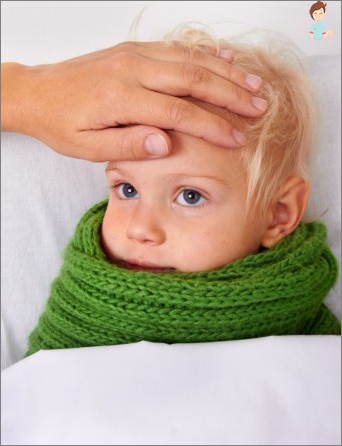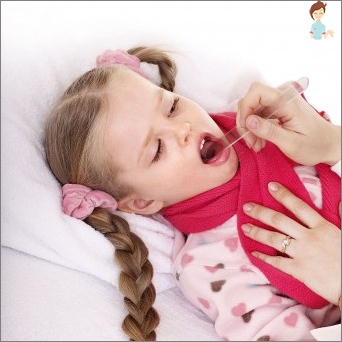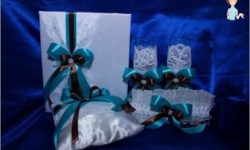Angina in a child
Purulent angina requires serious antibiotic therapy in order to avoid complications and inflammatory diseases in the body. How to treat this disease
Angina (it is acute tonsillitis) is one of the most common infectious diseases in children, starting from the sevenway age.

Angina in a child provoked mainly by viruses and bacteria. It is bacteria that initiate an angina in childhood about a third of all cases. At the same time, in 90-95% of cases, the causative agent is ?-Hemolytic Strelkokok. Viral forms of tonsillitis more often occur under 3 years.
In newborns and infants of the first months of life, not a stranger as such, but sharp naphorgitis.
Angina in infants and young children arises quite rarely, and it takes extremely difficult, so in such a situation it is necessary only inpatient treatment.
Streptococcal tonsillitis manifests itself as a lacunar or follicular angina in children.
Streptococcal tonsillitis – This is a poor pathology. The lymphatic tissue of the almonds is reacting to the appearance of an infectious agent in the body, but if it does not help to resist it, it can infection in it can disseminate in all organs and tissues and cause fairly severe complications.
Local complications include abscesses and purulent lymphadenitis, and entail surgical intervention in the body. The systemic refers to the sharp rheumatic fever, which develops after 2-3 weeks of the disease, less often damage to the kidneys, hearts, streptococcal toxic shock syndrome, brain, necrotizing fascia.
A child with angina caused by streptococci, contagiane (infectious) for those surrounding from the very beginning of the disease and without adequate treatment can remain contagious up to 2 weeks. Antibiotic therapy reduces this period to two days after the disease manifestation.
Symptoms of Disease
Symptoms of angina in children are the same, regardless of the infectious agent provoked the disease:
- A keen beginning of the disease, body temperature up to 40 degrees;
- Chills and cold sweat;
- Sharp throat pain;
- The adhesion of the almonds, tongue and walls of the pharynx;
- Raids on almonds;
- Loss of appetite or rejection of food, total lethargy.
Streptococcal angina is differentiated with viral on the presence or absence of nasal and cough discharge. Sometimes there is a soreness of cervical and submandibular lymph nodes.
To select adequate therapy, requires differential diagnosis of bacterial and viral etiology of the disease. Although, with these pathologies, symptoms are similar. This is important when selecting antibiotics necessary to eliminate bacteria and the relief of possible complications.
The main criterion of diagnosis is a culture study of the zaraza zez on hemolytic streptococcus. Today there are express methods that allow you to quickly determine this infectious agent in 90% of cases.
 In cases of standard culture research, it is necessary to wait for its results. Only on the basis of such an analysis can be prescribed to the effective treatment of acute purulent angina in children.
In cases of standard culture research, it is necessary to wait for its results. Only on the basis of such an analysis can be prescribed to the effective treatment of acute purulent angina in children.
This is due to the fact that in the process of cultural research, the sensitivity of bacteria to one or another antibiotics is checked.
By choosing antibiotics to which the infectious agent is most sensitive, the doctor picks up a dosage by the parameters of your child’s body (age, weight, gravity of the disease).
The practice has been proven that antibiotics on the second-third day in children with an angina effectively prevent the development of complications.
Treatment of angina in children provoked by streptococcal infection requires the use of antibiotics. These drugs are selected based on the sensitivity of the infectious agent defined on the basis of sowing.
The doctor chooses from penicillins, cephalosporins or macrolides. They can be used in a tablet version or in syrups for the smallest, as well as, at the discretion of the doctor, in difficult cases injectable or infusionally.
The purpose of antibiotic therapy is to complete the elimination of an infectious agent from the body. Such a tactic is needed for the prevention of relapses, and to prevent the occurrence of bacteria strains resistant to the action of this antibiotic. The main thing is not to interrupt treatment, even if the child’s condition has normalized.
In addition to antibiotics, it is also possible to treat an angina inhalations and sprays containing substances for a slope of the mucosa in the throat (inhalipt, will, tantuum verte). There are antibiotics in sprays (bioparox).

Also prescribe rinsing for removing purulent plates in the throat and preventing the spread of infection by the body. Inhalations are made with chlorophyllip, manganese, soda and iodine, furacilin.
Almond removal was widely used in past years, and now it is carried out only on strict indications (frequent relapses or rheumatic consequences of the disease).
Symptomatically prescribed antipyretic and painful agents. And do not forget about ventilation, wet cleaning and drinking mode for a diseased child.
Viral Angimes are treated with the relief of the symptoms that have arisen, and after the normalization of the body temperature, the observance of the rest mode is not required.
Among children are quite widespread, the so-called streptococcal carriage, while the number of bacteria in the body is small, it does not provoke the disease and is not contagious.
Thus, the diagnosis of purulent angina for a child is not a sentence at all, but for full cure, it is necessary that the doctor has decided to treat purulent angina in children, as well as to fully comply with all its recommendations and prescriptions.


